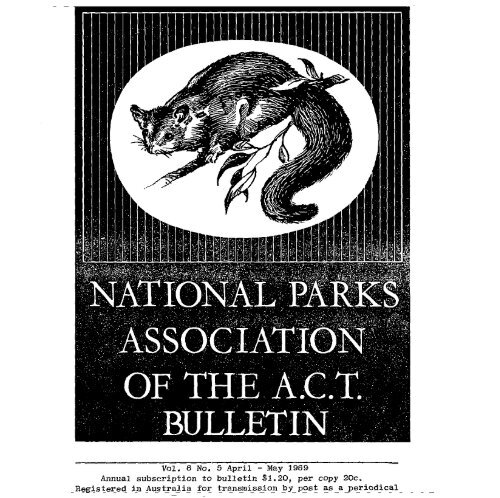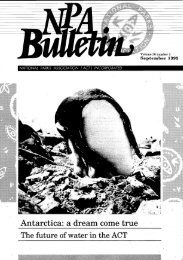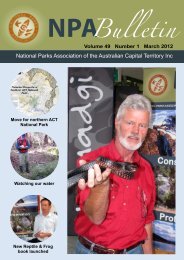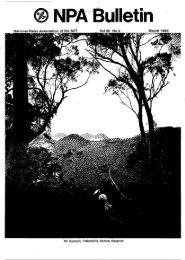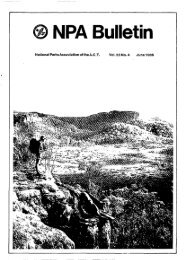Vol 6 No 5 Apr-May 1969 - NPAACT
Vol 6 No 5 Apr-May 1969 - NPAACT
Vol 6 No 5 Apr-May 1969 - NPAACT
Create successful ePaper yourself
Turn your PDF publications into a flip-book with our unique Google optimized e-Paper software.
<strong>Vol</strong>. 6 <strong>No</strong>. 5 <strong>Apr</strong>il - <strong>May</strong> <strong>1969</strong>Annual subscription to bulletin $1.20, per copy 20c.Registered in Australia for transmission by post as a periodical
NATIONAL PARKS ASSOCIATION OF THE A.C.T. INC."A NATIONAL PARK FOR THE NATIONAL CAPITAL"President : Mr. A.J, Brand, 11 Dyson Street, Lyneham (4.3538)Secretary : Miss I. Dahl, Box 457 P.O. Canberra CityTreasurer : Mr. J.L, Schunke, Box 457 P.O. Canberra City(4B.9828)Monthly Meeting: Third Tuesday of the Month"The" meeting of our year is fast approaching with the visitof Judith Wright to our <strong>Apr</strong>il meeting. The meeting -will beheld in the Playhouse, Civic Square in the hope of attractinga wide audience from the general public All members areurged to attend, to hear this great Australian writer andconservationist speak on the subject: "CONSERVATION AS ANEMERGING CONCEPT",MembershipThe association welcomes the following new members:Mr. & Mrs. Barnard; Mr. & Mrs. A.R.C. Morrison, Miss V.Pocknall; Mr. & Mrs. Rowland; Miss M. Weisher.Renewals : Mr. & Mrs. R.P. GreenishBook ReviewAustralian Grasses <strong>Vol</strong>. 2 <strong>No</strong>rthernTablelands of New South Walesby Nancy T. Burbidge, D.Sc.Angus and Robertson, Sydney, 1968 $8.50This is the second of a series of Australian grassbooksdesigned for those who are interested in the grasses of aparticular area and want to be able to identify and namethem correctly. Characteristic species are illustratedin groups according to the type of seedhead they possess.There is a concise description and a note on incidence andgrazing significance.Naturally many grasses of the <strong>No</strong>rthern Tablelands occur alsoin the A.C.T, and the Southern Tablelands, areas which weredealt with in volume 1. For this reason some species areincluded in both volumes. In other cases a closely relatedspecies has been shown. The two volumes are therefore complementaryto one another even though designed for use in districtswith different climates.
Australian Conservation Foundation Symposium on''The Future of the Great Barrier ReefAll members are invited to attend this symposium to be held atSydney University Union Theatre, Saturday <strong>May</strong> 3rd, <strong>1969</strong> at10.15 a.m. There will be offered by T.A.A., special group airlineconcession fares. Registration forms will be availablevery soon.Why a Symposium on the Great Barrier Reef? The conservation ofthe Great Barrier Reef is a national issue. Australia holds thereef in trust as one of the wonders of the modern world, and weare responsible to the world for its future.The symposium falls naturally into three parts. The firstdeals with what the Reef is, both physically and in terms ofits constitution, i.e. the law of the sea governing, or believedto be applicable to, the activities of governments.The second part concerns what the Reef has to offer man in theway of renewable and non-renewable resources; and the third -the crux of the symposium - what can be done to ensure itspresent unique identity, and also how its management by mancan be improved.A list of the speakers and their subjects and other informationmay be obtained from our secretary, Isobel Dahl.Quote from a British Columbia's publication "Wildlife Review":"Man's mastery of the earth will pay him greatesttribute when he achieves the forebearance to leavesome of it alone".
THINK!NINE little nigger boys full of fun and joyOne by one, the old tale tellsThey disappeared until there were N0NE.EIGHT bright Rosella dressed for carnivalWho wanted just one wing to decorate a hat?SEVEN solemn Wombats hunting in the darkWho set a trap, just for a lark?SIX lazy Lizards sunning on the rocksWho was it caught one and let it die in a box?FIVE Kangaroos resting in the shadeForced to run in panic from death man-made,FOUR Black Swans noble and sereneOil upon the water brings death or sickness mean.THREE furry Possums living in the treeFlames scorched the fur and eyes no longer see,TWO superb Lyrebirds mated for lifeWho killed the songster and left a mourning wife?ONE White Egret sailing on currents of airWho pulled the trigger by the lake so fair?One by one they die - or disappear.<strong>No</strong>t harsh Nature's reddened tooth or clawBut selfish willfulness of ManThe Destroyer, they learn to fear.N.T.B.
The following two paragraphs are from, an address given by AllenA. Strom, entitled "The <strong>Vol</strong>untary Citizen Organisation in theNature Conservation Programme" given to the WildlifePreservation Society and N.S.W.N.P.A.:"<strong>May</strong>be my reading and my experiences have been singularlyunfortunate, but I have yet to encounter a circumstance innature conservation where the effort to progress the programmehas not been a battle against apathy, or selfrighteousness, ordownright ignorance of the values of wildlife, natural environmentand natural phenomena, as resources upon which rests muchhuman welfare and happiness,, That this regrettable situationexists over the whole world, more or less, does not in theleast compensate for its eroding effects upon the much youngercommunities in Australia. Indeed, in this country, the socalled"spirit of pioneering" and the "last frontier againstuntamed nature" nonsense, continues to justify the exploitivebias of our land usage programmes and encourages thinking interms of one large bonanza in our time, and to hell with thefuture. Apparently achieving adulthood as a nation means tomost administrators and citizens, replacing diversity ofenvironment with a monotony of urbanity and industry on the onehand, and on the other, continuous lines of fenced paddocksenclosing only man-made or man-influenced ecosystems"."The <strong>Vol</strong>untary Citizen Organisations have caught up a streamof people who have been affected by naturalness in variousways. To some, the enjoyment of naturalness means a newinterest, a new recreation or a new way of securing a releasefrom routine and sophistication. Often the influence nevergoes further, but to others there comes a realisation that inreceiving something from nature they have a grave responsibilityto give something in return not because nature herself willbenefit, but because the resource may continue to be availablefor use by succeeding generations".
EYES OR NO EYES NO. 31The Currant Bush isa common shrub inour mountain areas.It grows in theforests of the upperslopes and is usuallyabout two to threefeet high.The Plants are easilyoverlookedexcept when theyare bearing thebright red or orangeredberries late inthe summer months.The berries are avery attractivecolour but not muchgood to eat. Thereis little flesh aroundthe hard centre andthe taste makes themouth feel dry.If you look closely you will see thatthe leaves are paired and oppositeand there is a minute tooth betweenthe members of each pair.The plants of Currant Bush, whichbotanists call Coprosma hirtella,are of two kinds. One has femaleflowers and develops berries. Theother has flowers which only producepollen and are therefore called maleor staminate plants.Currant Bush is in fruit along the Mount Franklin Road - haveyou seen it?N.T.B.
OUTINGS<strong>Apr</strong>ilDatePlaceFeatureEaster Weekend - 4th-7th <strong>Apr</strong>ilProposed National Park in the A.C.T.(a) A base camp for day walks;(b) a three day walk through the area,The base camp will be in a forestry area near Gudgenby.Directions as follows: through Tharwa to Naas, cross GudgenbyRiver, turn left off sealed road onto gravel road over a cattlegrid (sign "shannons Flat 25 miles"). After 9 miles crossGudgenby Creek bridge and after 300 yards turn right onto oldBoboyan Road. Travel on through two gates onto stock reserve.Cross ford, pass through two gates and at approximately 3 milesfrom turnoff turn left up forest track to huts in trees. (Map50,000 Yauk ref. 19975844). There is a hut for shelter in caseof rain and where a fire may be lit (no open air fires).Bring a water container as water will have to be taken from acreek, half a mile away. There will be short walks Friday andMonday and day walks to Mt, Gudgenby and Yankee Hat on Saturdayand Sunday. Members may wish to attend single daysonly. N.S.W.N.P.A. will be attending this outing. Members andvisitors will collect at base camp by mid-day. Anyone wishingto go on the three day walk please ring 4.3538 and their nameswill be passed on to the leader.Date : Sunday, 25th <strong>May</strong>, <strong>1969</strong>Place : Smokers Flat area which is the northernboundary of the proposed National Park.Meeting m Junction of Corin Dam Road and TidbinbillaPlace ' Road at 10.30 a.m.Feature : A six mile drive from meeting place and thena walk along a jeep track until lunch time.Return to cars by 3.30 p.m.
Meetings<strong>Apr</strong>ilDatePlaceFeatureTuesday, 15th <strong>Apr</strong>il at 8.00 p.m."The Playhouse' , Civic SquareOur guest speaker will be the famousAustralian writer and conservationistJudith Wright whose subject will be:"CONSERVATION AS AN EMERGING CONCEPT"Publicise this meeting as widely as possible.<strong>May</strong>DatePlaceFeatureTuesday, 20th <strong>May</strong> at 8.00 p.m.Institute of AnatomyFilm evening:"Offspring of Isolation""Creatures of the Dawn""island of Birds""Australian Coral WonderlandVisitors welcome.


